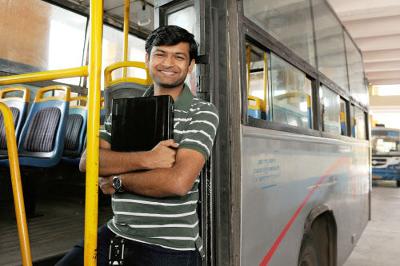
Seeing the bigger opportunity and teaching yourself the skills to seize it – the redBus story
It was approaching Diwali in 2005 and Phanindra Sama was trying to get a bus ticket from Bangalore, where he was working for Texas Instruments, to his hometown Hyderabad.
His regular travel agent didn’t have any, nor did the many others he approached. Tickets for buses in India are traditionally sold in lots of little kiosks, but none of the ones Phani, as he is widely known, visited, had any left.
So disappointed, he returned to his flat in Koramangala, a flat he shared with six friends, all of whom had studied engineering at BITS Pilani.
There after bemoaning his bad luck, he got to wondering was there a travel agent somewhere in city who had had a ticket left. Had that ticket remained unsold? In which case everybody – him, the travel agent, and the bus operator – had lost an opportunity.
And how many other opportunities had been missed too?
It didn’t take long before Phani could see a bigger opportunity.
When his flatmates returned, he put his idea to them. Could the internet be the solution, a web site where all bus operators could put in their seat inventory and people could buy those online.
It was simple. It was brilliant but there a problem. “We didn’t know anything about the bus industry. We didn’t even know anything about software or websites. I was designing microchips and he (Charan Padmaraju, one of his flatmates who would join him in the venture) was doing embedded design. We actually bought textbooks on how to write software and started learning,”
They met with various people – bus operators, passengers and venture capitalists – to gauge how well the concept could do. Everyone they spoke to was excited.
They then put together a business plan and presented it to TiE – The Indus Entrepreneurs, Bangalore Chapter who act as mentors and inubators. The idea didn’t need much selling to TiE members either.
The founders decided to quit their jobs and the real journey began.
 India has more than 5,000 inter-city bus operators with 5 to 500 buses each. They were used to dealing with traditional brick-and-mortar travel agents, so changing their mindset of the bus wasn’t easy. Along with developing the website, it took a few months for everything to fall in place.
India has more than 5,000 inter-city bus operators with 5 to 500 buses each. They were used to dealing with traditional brick-and-mortar travel agents, so changing their mindset of the bus wasn’t easy. Along with developing the website, it took a few months for everything to fall in place.
The name redBus is a combination and a bit of borrowed inspiration: “We wanted a colour in the name of our site. And an easy, short word is always best for the Web. ‘Red’ was the shortest. It also denotes energy, youthfulness. I was then reading Richard Branson’s autobiography and that was hugely inspiring, and his Virgin was red,” Phani says.
Finally, they were ready and in August 2006, they took their first booking. Perhaps surprisingly there was as much nervousness as there was excitement at the website’s office. Would the conductor allow the traveller in? He might never have seen a computer printed bus ticket before.
“We were scared,” recalls Phani “So we all went to the bus stand to board the customer, who was a lady from Infosys going to Tirupati. It was an auspicious beginning.”
Since then the brand has gone from strength to strength. They now have 1500+ bus operators and 80,000 routes covered. They sell over a million tickets a month. In 2012, ‘Fast Company’ named redBus amongst the world’s 50 most innovative companies, alongside Apple, Facebook and Google